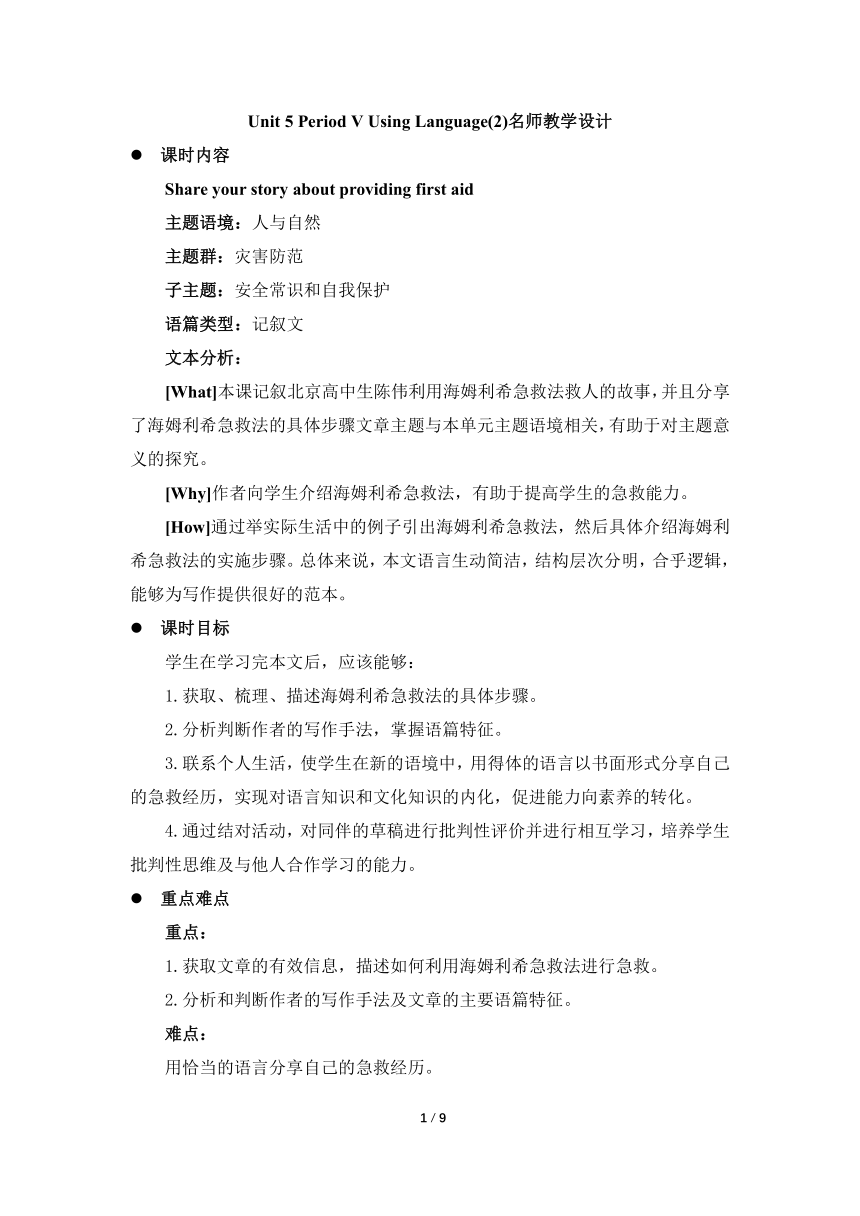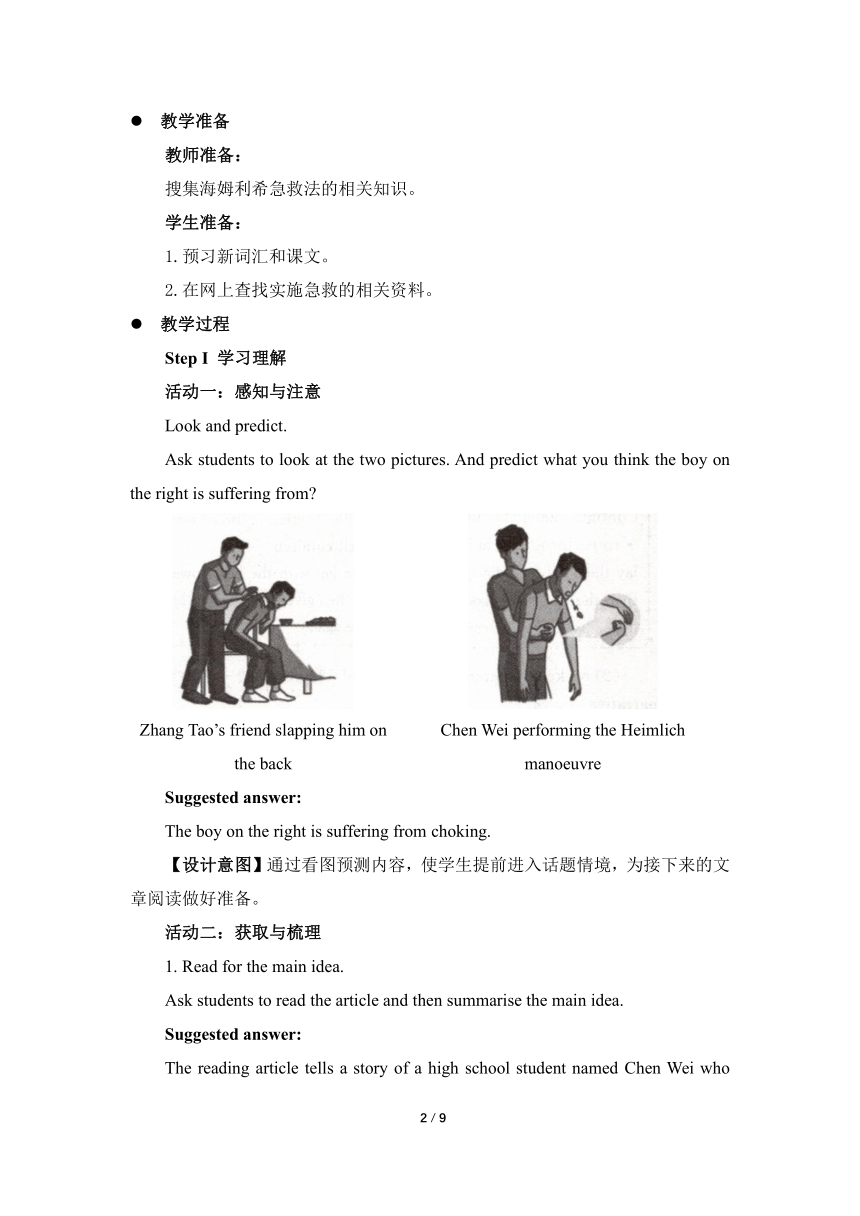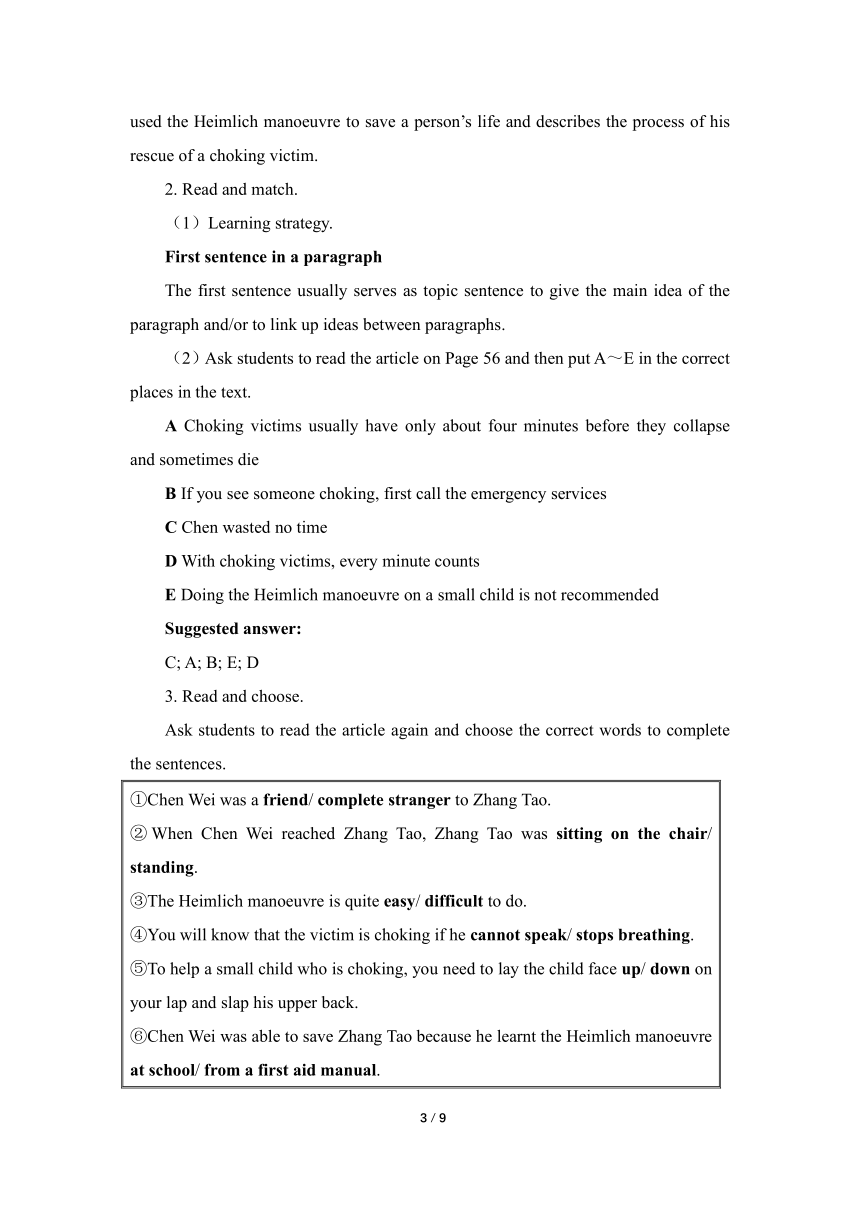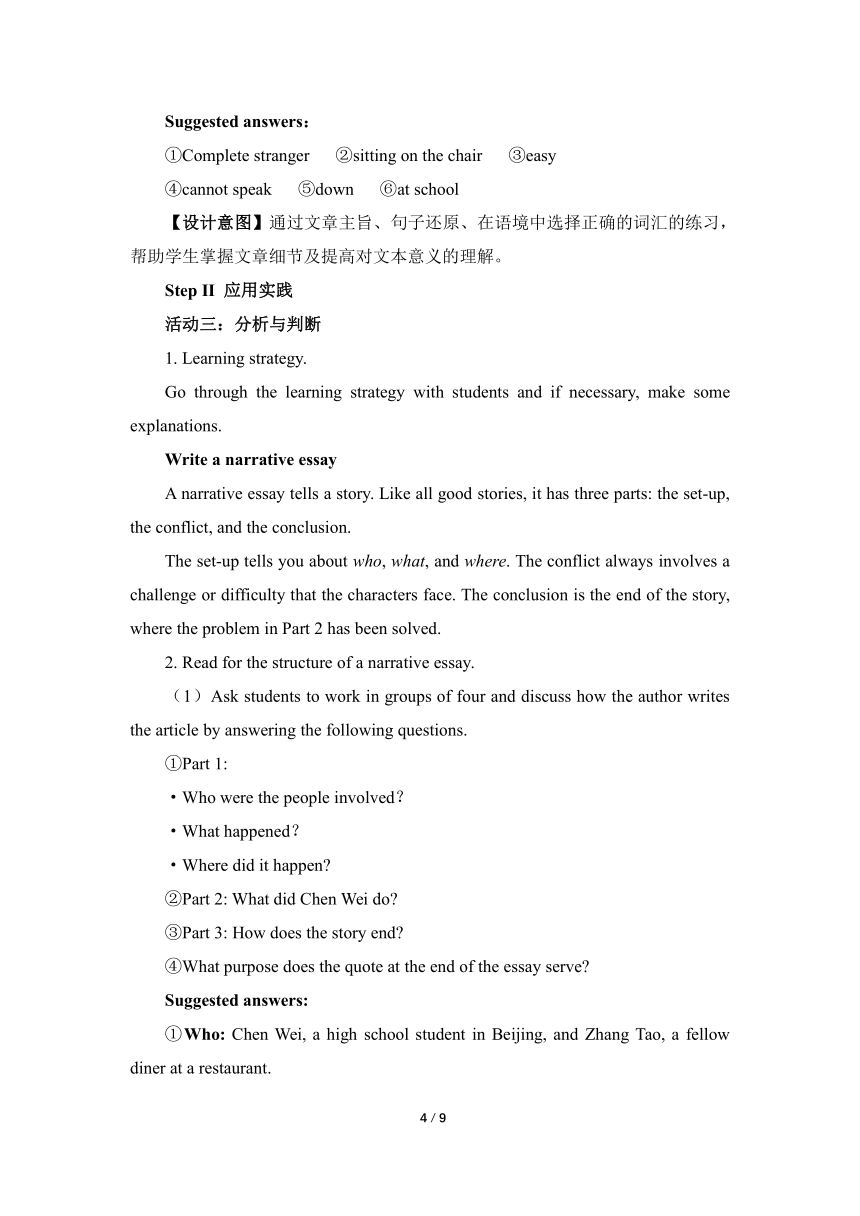人教版(2019)高中英语选择性必修第二册 Unit5 First Aid Using Language(2) 名师教学设计
文档属性
| 名称 | 人教版(2019)高中英语选择性必修第二册 Unit5 First Aid Using Language(2) 名师教学设计 |  | |
| 格式 | docx | ||
| 文件大小 | 520.4KB | ||
| 资源类型 | 教案 | ||
| 版本资源 | 人教版(2019) | ||
| 科目 | 英语 | ||
| 更新时间 | 2023-03-12 19:58:24 | ||
图片预览




文档简介
Unit 5 Period Ⅴ Using Language(2)名师教学设计
课时内容
Share your story about providing first aid
主题语境:人与自然
主题群:灾害防范
子主题:安全常识和自我保护
语篇类型:记叙文
文本分析:
[What]本课记叙北京高中生陈伟利用海姆利希急救法救人的故事,并且分享了海姆利希急救法的具体步骤文章主题与本单元主题语境相关,有助于对主题意义的探究。
[Why]作者向学生介绍海姆利希急救法,有助于提高学生的急救能力。
[How]通过举实际生活中的例子引出海姆利希急救法,然后具体介绍海姆利希急救法的实施步骤。总体来说,本文语言生动简洁,结构层次分明,合乎逻辑,能够为写作提供很好的范本。
课时目标
学生在学习完本文后,应该能够:
1.获取、梳理、描述海姆利希急救法的具体步骤。
2.分析判断作者的写作手法,掌握语篇特征。
3.联系个人生活,使学生在新的语境中,用得体的语言以书面形式分享自己的急救经历,实现对语言知识和文化知识的内化,促进能力向素养的转化。
4.通过结对活动,对同伴的草稿进行批判性评价并进行相互学习,培养学生批判性思维及与他人合作学习的能力。
重点难点
重点:
1.获取文章的有效信息,描述如何利用海姆利希急救法进行急救。
2.分析和判断作者的写作手法及文章的主要语篇特征。
难点:
用恰当的语言分享自己的急救经历。
教学准备
教师准备:
搜集海姆利希急救法的相关知识。
学生准备:
1.预习新词汇和课文。
2.在网上查找实施急救的相关资料。
教学过程
Step I 学习理解
活动一:感知与注意
Look and predict.
Ask students to look at the two pictures. And predict what you think the boy on the right is suffering from
Zhang Tao’s friend slapping him on the back Chen Wei performing the Heimlich manoeuvre
Suggested answer:
The boy on the right is suffering from choking.
【设计意图】通过看图预测内容,使学生提前进入话题情境,为接下来的文章阅读做好准备。
活动二:获取与梳理
1. Read for the main idea.
Ask students to read the article and then summarise the main idea.
Suggested answer:
The reading article tells a story of a high school student named Chen Wei who used the Heimlich manoeuvre to save a person’s life and describes the process of his rescue of a choking victim.
2. Read and match.
(1)Learning strategy.
First sentence in a paragraph
The first sentence usually serves as topic sentence to give the main idea of the paragraph and/or to link up ideas between paragraphs.
(2)Ask students to read the article on Page 56 and then put A~E in the correct places in the text.
A Choking victims usually have only about four minutes before they collapse and sometimes die
B If you see someone choking, first call the emergency services
C Chen wasted no time
D With choking victims, every minute counts
E Doing the Heimlich manoeuvre on a small child is not recommended
Suggested answer:
C; A; B; E; D
3. Read and choose.
Ask students to read the article again and choose the correct words to complete the sentences.
①Chen Wei was a friend/ complete stranger to Zhang Tao. ②When Chen Wei reached Zhang Tao, Zhang Tao was sitting on the chair/ standing. ③The Heimlich manoeuvre is quite easy/ difficult to do. ④You will know that the victim is choking if he cannot speak/ stops breathing. ⑤To help a small child who is choking, you need to lay the child face up/ down on your lap and slap his upper back. ⑥Chen Wei was able to save Zhang Tao because he learnt the Heimlich manoeuvre at school/ from a first aid manual.
Suggested answers:
①Complete stranger ②sitting on the chair ③easy
④cannot speak ⑤down ⑥at school
【设计意图】通过文章主旨、句子还原、在语境中选择正确的词汇的练习,帮助学生掌握文章细节及提高对文本意义的理解。
Step Ⅱ 应用实践
活动三:分析与判断
1. Learning strategy.
Go through the learning strategy with students and if necessary, make some explanations.
Write a narrative essay
A narrative essay tells a story. Like all good stories, it has three parts: the set-up, the conflict, and the conclusion.
The set-up tells you about who, what, and where. The conflict always involves a challenge or difficulty that the characters face. The conclusion is the end of the story, where the problem in Part 2 has been solved.
2. Read for the structure of a narrative essay.
(1)Ask students to work in groups of four and discuss how the author writes the article by answering the following questions.
①Part 1:
·Who were the people involved?
·What happened?
·Where did it happen
②Part 2: What did Chen Wei do
③Part 3: How does the story end
④What purpose does the quote at the end of the essay serve
Suggested answers:
①Who: Chen Wei, a high school student in Beijing, and Zhang Tao, a fellow diner at a restaurant.
What: Zhang Tao was choking on some steak while eating.
Where: At a restaurant.
②Chen Wei performed the Heimlich manoeuvre on Zhang Tao.
③Chen Wei saved Zhang Tao, then the ambulance came and doctors checked Zhang Tao and said that he t was fine.
④It provides a good way to wrap up the essay. It also t tells the reader about Chen Wei’s emotions and opinions, and gives unique insight into his character.
(2)Ask students to work in groups of four and discuss the structure of a narrative essay.
Suggested answer:
The structure of a narrative essay:
the set-up: who, what, and where
the conflict: a challenge or difficulty
the conclusion: the end of the story
3. Analyse the language features of narrative essays.
(1)Ask students to read again and underline the language or describing actions:
·to introduce the emergency
·to perform Heimlich manoeuvre
·to perform first aid on small children
Suggested answers:
·to introduce the emergency
Zhang Tao, was choking on some steak holding his throat with his face turning red
·to perform Heimlich manoeuvre
make sure that the victim is really choking standing behind him and wrapping your arms around his waist
Make a fist with one hand and place it in the upper t part of his stomach.
Grabbing your fist with your other hand tightly, push up and into his stomach in one motion.
Continue doing this until the obstruction is forced out.
·to perform first aid on small children
lay the child face down on your lap with the head lower than the rest of his body, and then give firm slaps to his upper back until he can breathe again
(2)Make a summary about the language features of narrative essays.
Ask students to work in groups of four and discuss the language features of narrative essays.
Suggested answer:
Language features of narrative essays:
clear and concise
written in the first person or third person
written in active voice
more casual words and phrases
【设计意图】通过分析记叙文的写作手法、识别文本特征和语言特征,可以提高学生对记叙文的认识,也为下一步的写作打好语言基础。
活动四:内化与应用
Write a narrative essay that shares a story about providing first aid.
(1)Brainstorming.
Ask students to work in groups and recall their experiences of giving first aid in an emergency. If they have never had any experiences, share stories they have read or heard about, or think up a situation.
(2)Fill in the blanks.
After sharing their experiences, ask students to sort out the structures by filling in the blanks.
Questions Key words
Part 1 Who What Where
Part 2 The process
Part 3 The end
Part 4 Any comments
(3)Ask students to write an outline of their story and think of a good quote to sum things up.
(4)Ask students to write their narrative essay.
Possible answer 1:
One morning, David was working at his home while watching his infant daughter Jane who was crawling on the floor. Suddenly, he noticed that she had picked something up and put it in her mouth. Then she began to move like she was struggling. He quickly jumped from his chair and ran over and picked her up. Going back to his chair, he held her in his lap and saw that she was still struggling with a frightened t look on her face. However, she was not crying or making a sound.
He carefully opened her mouth to see if there was obstruction. Not finding anything, he then gave her a few hard slaps on her back.
It worked! Within seconds a small button fell from her mouth onto the floor, and she was breathing once again. Thanks to David’s quick thinking, Jane was saved.
David now teaches life-saving techniques at the local college, and he uses this story to impress upon students the need for quick action.“When seconds count,”he said,“an ambulance is often minutes away.”
Possible answer 2:
A boy fell ill. His organs were damaged by the radiation of an infrared ray stove. But before the t ambulance arrived, a number of other injuries happened to this unlucky boy over and over again.
First, he was choked by some poisonous liquid from the kettle on the cupboard. Then his wrist skin was burnt by electric shock. Finally, his ankle was cut by a knife.
Fortunately, the boy’s nurse gave him proper temporary treatments according to his complex t symptoms. She mildly squeezed the poisonous liquid out of his throat and put bandages firmly in place to apply pressure to the ankle wound to stop bleeding. As for the burn, she used scissors to remove his sleeve, poured a basin of cold water over the burn to cool it and put her hands on a damp blouse to cover his swollen tissue tightly. She also inspired his bravery to fight against the unbearable pain.
Her first aid made a vital difference in saving his life. A ceremony was held to honour the nurse who overcame a variety of barriers to save the boy.
【设计意图】本活动为写作实践,在写前设计小组活动,引导学生对写作内容和写作结构进行讨论,旨在降低写作难度,增强学生对写作的信心。
Step Ⅲ 迁移创新
活动五:批判与评价
Exchange your draft with a partner.
(1)Use the checklist to help you revise your partner’s draft.
√ Is the narrative essay clear
√ Does it have three parts
√ Does the first part tell you about who, what, and where
√ Does the second part show a conflict
√ Does the third part give the conclusion
√ Is there a good quote to sum things up
√ Are the details of the story easy to understand?
(2)Share your essay with the rest of the class.
【设计意图】通过与同伴合作,探讨记叙文的要素及在文章中分布情况、文章的结尾及故事情节的描写等,加深对主题意义的理解和批判思维及多元思维的培养,实现深度学习。
板书设计
Unit 5 First Aid Period Ⅴ Using Language(2) I.学习理解 活动一:感知与注意 活动二:获取与梳理 1. Read for the main idea. 2. Read and match. 3. Read and choose. Ⅱ.应用实践 活动三:分析与判断 1. Learning strategy. 2. Read for the structure of a narrative essay. 3. Analyse the language features of narrative essays. 活动四:内化与应用 Ⅲ.迁移创新 活动五:批判与评价 Exchange your draft with a partner.
2 / 2
课时内容
Share your story about providing first aid
主题语境:人与自然
主题群:灾害防范
子主题:安全常识和自我保护
语篇类型:记叙文
文本分析:
[What]本课记叙北京高中生陈伟利用海姆利希急救法救人的故事,并且分享了海姆利希急救法的具体步骤文章主题与本单元主题语境相关,有助于对主题意义的探究。
[Why]作者向学生介绍海姆利希急救法,有助于提高学生的急救能力。
[How]通过举实际生活中的例子引出海姆利希急救法,然后具体介绍海姆利希急救法的实施步骤。总体来说,本文语言生动简洁,结构层次分明,合乎逻辑,能够为写作提供很好的范本。
课时目标
学生在学习完本文后,应该能够:
1.获取、梳理、描述海姆利希急救法的具体步骤。
2.分析判断作者的写作手法,掌握语篇特征。
3.联系个人生活,使学生在新的语境中,用得体的语言以书面形式分享自己的急救经历,实现对语言知识和文化知识的内化,促进能力向素养的转化。
4.通过结对活动,对同伴的草稿进行批判性评价并进行相互学习,培养学生批判性思维及与他人合作学习的能力。
重点难点
重点:
1.获取文章的有效信息,描述如何利用海姆利希急救法进行急救。
2.分析和判断作者的写作手法及文章的主要语篇特征。
难点:
用恰当的语言分享自己的急救经历。
教学准备
教师准备:
搜集海姆利希急救法的相关知识。
学生准备:
1.预习新词汇和课文。
2.在网上查找实施急救的相关资料。
教学过程
Step I 学习理解
活动一:感知与注意
Look and predict.
Ask students to look at the two pictures. And predict what you think the boy on the right is suffering from
Zhang Tao’s friend slapping him on the back Chen Wei performing the Heimlich manoeuvre
Suggested answer:
The boy on the right is suffering from choking.
【设计意图】通过看图预测内容,使学生提前进入话题情境,为接下来的文章阅读做好准备。
活动二:获取与梳理
1. Read for the main idea.
Ask students to read the article and then summarise the main idea.
Suggested answer:
The reading article tells a story of a high school student named Chen Wei who used the Heimlich manoeuvre to save a person’s life and describes the process of his rescue of a choking victim.
2. Read and match.
(1)Learning strategy.
First sentence in a paragraph
The first sentence usually serves as topic sentence to give the main idea of the paragraph and/or to link up ideas between paragraphs.
(2)Ask students to read the article on Page 56 and then put A~E in the correct places in the text.
A Choking victims usually have only about four minutes before they collapse and sometimes die
B If you see someone choking, first call the emergency services
C Chen wasted no time
D With choking victims, every minute counts
E Doing the Heimlich manoeuvre on a small child is not recommended
Suggested answer:
C; A; B; E; D
3. Read and choose.
Ask students to read the article again and choose the correct words to complete the sentences.
①Chen Wei was a friend/ complete stranger to Zhang Tao. ②When Chen Wei reached Zhang Tao, Zhang Tao was sitting on the chair/ standing. ③The Heimlich manoeuvre is quite easy/ difficult to do. ④You will know that the victim is choking if he cannot speak/ stops breathing. ⑤To help a small child who is choking, you need to lay the child face up/ down on your lap and slap his upper back. ⑥Chen Wei was able to save Zhang Tao because he learnt the Heimlich manoeuvre at school/ from a first aid manual.
Suggested answers:
①Complete stranger ②sitting on the chair ③easy
④cannot speak ⑤down ⑥at school
【设计意图】通过文章主旨、句子还原、在语境中选择正确的词汇的练习,帮助学生掌握文章细节及提高对文本意义的理解。
Step Ⅱ 应用实践
活动三:分析与判断
1. Learning strategy.
Go through the learning strategy with students and if necessary, make some explanations.
Write a narrative essay
A narrative essay tells a story. Like all good stories, it has three parts: the set-up, the conflict, and the conclusion.
The set-up tells you about who, what, and where. The conflict always involves a challenge or difficulty that the characters face. The conclusion is the end of the story, where the problem in Part 2 has been solved.
2. Read for the structure of a narrative essay.
(1)Ask students to work in groups of four and discuss how the author writes the article by answering the following questions.
①Part 1:
·Who were the people involved?
·What happened?
·Where did it happen
②Part 2: What did Chen Wei do
③Part 3: How does the story end
④What purpose does the quote at the end of the essay serve
Suggested answers:
①Who: Chen Wei, a high school student in Beijing, and Zhang Tao, a fellow diner at a restaurant.
What: Zhang Tao was choking on some steak while eating.
Where: At a restaurant.
②Chen Wei performed the Heimlich manoeuvre on Zhang Tao.
③Chen Wei saved Zhang Tao, then the ambulance came and doctors checked Zhang Tao and said that he t was fine.
④It provides a good way to wrap up the essay. It also t tells the reader about Chen Wei’s emotions and opinions, and gives unique insight into his character.
(2)Ask students to work in groups of four and discuss the structure of a narrative essay.
Suggested answer:
The structure of a narrative essay:
the set-up: who, what, and where
the conflict: a challenge or difficulty
the conclusion: the end of the story
3. Analyse the language features of narrative essays.
(1)Ask students to read again and underline the language or describing actions:
·to introduce the emergency
·to perform Heimlich manoeuvre
·to perform first aid on small children
Suggested answers:
·to introduce the emergency
Zhang Tao, was choking on some steak holding his throat with his face turning red
·to perform Heimlich manoeuvre
make sure that the victim is really choking standing behind him and wrapping your arms around his waist
Make a fist with one hand and place it in the upper t part of his stomach.
Grabbing your fist with your other hand tightly, push up and into his stomach in one motion.
Continue doing this until the obstruction is forced out.
·to perform first aid on small children
lay the child face down on your lap with the head lower than the rest of his body, and then give firm slaps to his upper back until he can breathe again
(2)Make a summary about the language features of narrative essays.
Ask students to work in groups of four and discuss the language features of narrative essays.
Suggested answer:
Language features of narrative essays:
clear and concise
written in the first person or third person
written in active voice
more casual words and phrases
【设计意图】通过分析记叙文的写作手法、识别文本特征和语言特征,可以提高学生对记叙文的认识,也为下一步的写作打好语言基础。
活动四:内化与应用
Write a narrative essay that shares a story about providing first aid.
(1)Brainstorming.
Ask students to work in groups and recall their experiences of giving first aid in an emergency. If they have never had any experiences, share stories they have read or heard about, or think up a situation.
(2)Fill in the blanks.
After sharing their experiences, ask students to sort out the structures by filling in the blanks.
Questions Key words
Part 1 Who What Where
Part 2 The process
Part 3 The end
Part 4 Any comments
(3)Ask students to write an outline of their story and think of a good quote to sum things up.
(4)Ask students to write their narrative essay.
Possible answer 1:
One morning, David was working at his home while watching his infant daughter Jane who was crawling on the floor. Suddenly, he noticed that she had picked something up and put it in her mouth. Then she began to move like she was struggling. He quickly jumped from his chair and ran over and picked her up. Going back to his chair, he held her in his lap and saw that she was still struggling with a frightened t look on her face. However, she was not crying or making a sound.
He carefully opened her mouth to see if there was obstruction. Not finding anything, he then gave her a few hard slaps on her back.
It worked! Within seconds a small button fell from her mouth onto the floor, and she was breathing once again. Thanks to David’s quick thinking, Jane was saved.
David now teaches life-saving techniques at the local college, and he uses this story to impress upon students the need for quick action.“When seconds count,”he said,“an ambulance is often minutes away.”
Possible answer 2:
A boy fell ill. His organs were damaged by the radiation of an infrared ray stove. But before the t ambulance arrived, a number of other injuries happened to this unlucky boy over and over again.
First, he was choked by some poisonous liquid from the kettle on the cupboard. Then his wrist skin was burnt by electric shock. Finally, his ankle was cut by a knife.
Fortunately, the boy’s nurse gave him proper temporary treatments according to his complex t symptoms. She mildly squeezed the poisonous liquid out of his throat and put bandages firmly in place to apply pressure to the ankle wound to stop bleeding. As for the burn, she used scissors to remove his sleeve, poured a basin of cold water over the burn to cool it and put her hands on a damp blouse to cover his swollen tissue tightly. She also inspired his bravery to fight against the unbearable pain.
Her first aid made a vital difference in saving his life. A ceremony was held to honour the nurse who overcame a variety of barriers to save the boy.
【设计意图】本活动为写作实践,在写前设计小组活动,引导学生对写作内容和写作结构进行讨论,旨在降低写作难度,增强学生对写作的信心。
Step Ⅲ 迁移创新
活动五:批判与评价
Exchange your draft with a partner.
(1)Use the checklist to help you revise your partner’s draft.
√ Is the narrative essay clear
√ Does it have three parts
√ Does the first part tell you about who, what, and where
√ Does the second part show a conflict
√ Does the third part give the conclusion
√ Is there a good quote to sum things up
√ Are the details of the story easy to understand?
(2)Share your essay with the rest of the class.
【设计意图】通过与同伴合作,探讨记叙文的要素及在文章中分布情况、文章的结尾及故事情节的描写等,加深对主题意义的理解和批判思维及多元思维的培养,实现深度学习。
板书设计
Unit 5 First Aid Period Ⅴ Using Language(2) I.学习理解 活动一:感知与注意 活动二:获取与梳理 1. Read for the main idea. 2. Read and match. 3. Read and choose. Ⅱ.应用实践 活动三:分析与判断 1. Learning strategy. 2. Read for the structure of a narrative essay. 3. Analyse the language features of narrative essays. 活动四:内化与应用 Ⅲ.迁移创新 活动五:批判与评价 Exchange your draft with a partner.
2 / 2
